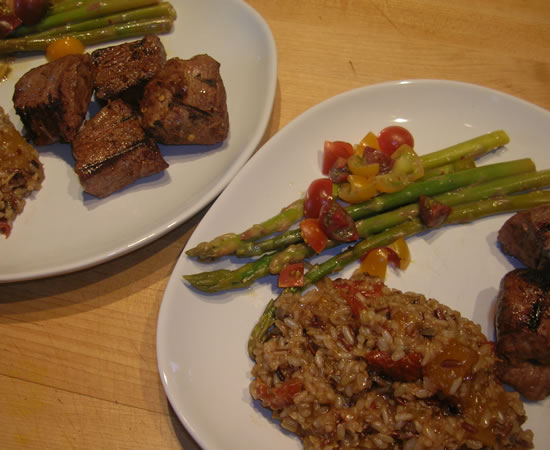It’s no secret that I love flavorful-hot and spicy foods. Schezuan, hot Indian or Thai curries, Ethiopian berberé (a woman I worked with at UCSF made it fresh for me!), hot and spicy Mexican chilis, boonie peppers from Guam (thanks, Jay!), and piri-piri from Mozambique, to name but a few.
They’re all different. All unique.
Tonight’s meal started with some beef tips I had cut, marinated in the Mozambique piri-piri, vacuum-packed, and froze. I picked up the piri-piri (which, literally means “chilly-chilly” in Swahili) at Cost Plus last time we were home. (I also got lots of berberé that trip because Mewded is not around to make it for me, anymore.) It has a nice kick. Traditional recipes for the spice blend (piri-piri can either be the pepper itself or a spice blend or condiment) vary, but the addition of lemon is very common.
Homemade Piri-Piri Sauce
- 10 red hot chiles (birds eye-type are best)
- 1/2 cup fresh lemon juice
- 2 T. finely chopped cilantro
- 1 T. chopped parsley
- 5 chopped garlic cloves
- 1/2 t. salt
- 1/2 cup peanut oil
Mash everything but oil in a food processor. Slowly drizzle in oil.
It should keep – refrigerated – for a goodly amount of time.
So… with spicy beef cubes as the main plate, and leftover chilled asparagus from yesterday, I decided we needed an accompanying rice. Wishing to stay on the African continent, I typed in “Mozambique Rice” and didn’t find much. I started searching a little deeper and found Zanzibar Pilau. Zanzibar is just north of Mozambique, so, at least I was in the right part of the world.
Unfortunately, the recipe was for a whole meal – and I really just wanted rice.
I improvised.
Here’s the recipe I started with:
Zanzibar Pilau
The word pilau comes from the Persian word pilav or pilaw, which is also the origin of pilaf, as in “rice pilaf”. The pilav rice cooking technique is found throughout the Middle East and West Asia (i.e., Turkey, India, Pakistan). It has been spread across Africa by the Arabs, and was brought by enslaved Africans to the Americas. It is especially common in the Caribbean and Southern United States. In West Africa and the Americas the name has become pearlu, perloo, perlau, plaw, et cetera. Whatever the name, it is rice, vegetables, and meat cooked in a seasoned broth. Here is the Swahili way to make this omnipresent rice dish. See also: Biriani.
women in the comorosWhat you need
- one-half teaspoon cumin seeds
- one-half teaspoon whole black peppercorns
- several whole cloves (“cloves” not “cloves of garlic”)
- one cinnamon stick (or a few pinches ground cinnamon)
- a few cardamom pods (or a few pinches ground cardamom)
- oil for frying
- several cloves of garlic
- two teaspoons fresh ginger
- three cups of rice (uncooked)
- two to four onions, chopped
- one to two pounds of meat (beef, chicken, mutton, fish, shrimp, or prawns), cut into bite-sized pieces
- two to four tomatoes, chopped (or canned tomatoes)
- two to four potatoes, peeled and cut into quarters
- one apple, peeled and cut into slices (optional)
- one cup raisins or sultanas (optional)
What you do
* Combine cumin, peppercorns, cloves, cinnamon and cardamom in a teacup, cover with warm water, stir, and set aside. (Cooking tip: The spices can be tied up in a small sack, like a tea bag, or can be put into a tea infuser before being placed in the warm water. This avoids having whole spices in the dish when it is served.)
* Pound the garlic and ginger together and set aside. Wash the rice, drain, and set aside.
* Heat oil in deep pot. Fry onions until clear. Stir. Add garlic and ginger. Continue stirring and frying until the flavors have mixed — it should develop a nice aroma.
* Add the meat, stir and cook over high heat until meat is browned on the outside. Reduce heat and simmer for a few minutes. Remove the meat and most of the onions, and set them aside. Add the rice and stir it thoroughly to coat each grain of rice with the oil. Add the spices and water. Stir. Wait five minutes. Add the tomatoes. Cover and simmer for a few minutes. Stir occasionally.
* Check every few minutes to see if more water is needed and add water (or broth) as necessary. Stir as liquid is added. After ten minutes add the potatoes (and/or the optional apples or raisins) and the meat and onions. Keep covered, keep checking, add water if bottom of pot is dry. Continue cooking over low heat for ten more minutes.
* Remove pot from stove, keep covered. Place entire pot in warm oven for an additional ten to twenty minutes. All moisture should be absorbed by rice and potatoes should be tender. Serve hot.
I had seen several recipes out there including one that had coconut and mango, so I just combined them.
The Quick Version
I sliced a small onion and sauteed it in a pat of butter. I then added about a half-teaspoon each of cumin, cloves, cinnamon, ginger, and cardamom to the pot and cooked it all until it was really fragrant. I then added 1 cup of whole grain brown rice and coated it with the spices and onions. Next went 2 cups of beef broth (since I was cooking beef) about 8 sliced sun-dried tomatoes, about a cup of cubed mango and a half-cup of shredded coconut.
Bring to boil, cover, reduce heat and simmer for 45 minutes.
I know it worked well because Victor cleaned his plate!
We saved the leftovers and I am going to rework it into a rice salad tomorrow.
Yum.

